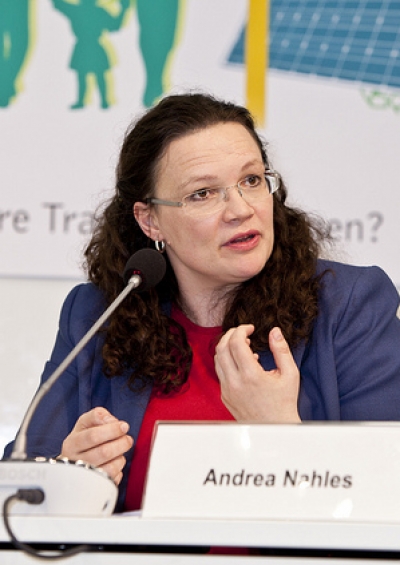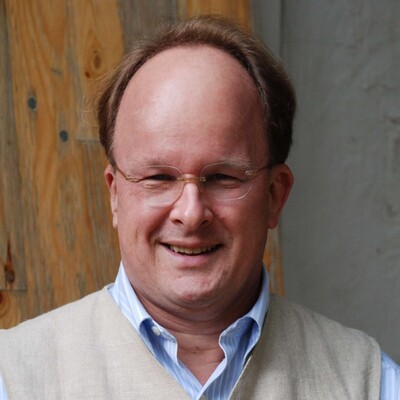SPD: Andrea Nahles’ Elusive Task
Why it is practically impossible for the SPD to reinvent itself.
April 24, 2018

First, after a brief, but intense period of hype in 2017, the SPD rapidly dispensed with Martin Schulz. Now, the contours of the next SPD-related hype that will rapidly fizzle are already clearly in sight. Andrea Nahles will be next.
As it stands, the only glue that still holds the SPD together is the desire to “reinvent” the SPD. But the mantra-like repetition of that claim is the only commonality.
Officially, the task ahead is to equip the SPD with a hip, state-of-the-art political program that gives Germany’s “VOP” (venerable old party) a big injection of new lifeblood.
Practically, what the party’s establishment and the party’s left wing mean by that are much stronger voting percentages in elections – preferably back to the glorious times when the party scored in the 40% range.
The Greens
But there is a little problem. The turf onto which the SPD desperately wants to move is already being usurped by a much nimbler, much younger party, the Greens.
Under the twin leadership of Robert Habeck and Annalena Baerbock, the Greens – in an effort to broaden their base – are determined to focus on the new social challenges, especially finding proper answers to the digitalization of work.
Indications are that the Greens are going to be much more successful in this mission than the SPD. It is for good reason that the SPD is nicknamed “old auntie.” It is solid, but not exciting.
At the core, the SPD is fighting a serious case of “mission accomplished.” The party’s traditional task, going back to its founding in 1863, is to tame capitalism and fight for strong worker rights. That task has largely been accomplished in Germany – as long as the measuring rod is international comparison, not perfection.
The SPD’s constant inclination to talk about social harshness, if not regression, is a politically tricky maneuver. It not only makes hash of its own past performance (which is very impressive). By playing to the bottom 20% of the income scale, it essentially becomes a special interest party, limiting its potential to grow at the political center.
The new social question
The digitalization challenge can certainly be viewed as the “new social question.” But from all the relevant perspectives – intellectual crispness, the novelty aspect, credibility and authenticity – the Greens are bound to eat the SPD’s cake on this issue.
A key reason for this is that the Greens in the past have proven very capable to make a great deal of political hay by operating as a near-monothematic party. The ardent pursuit of environmentalism launched them in the German political landscape. Now that this movement has become quite mainstream, socio-economic issues are the Greens’ new focus area.
The Greens can also be counted upon to be unrelenting in their steadfast support of ultra-liberal refugee policies. That is, in part, a matter of principle, but this policy plank also reflects a hard-nosed political calculation. The Greens are positioning themselves to benefit from the potential added support of SPD voters that are bound to be frustrated by their party’s gradual turn to a more conservative course on refugee policy.
This foreshadows the cardinal problem which Andrea Nahles and the entire SPD face with “Mission Reinvent.” Those who are keenest on it are actually on the left wing of the party.
The SPD’s core competency and voting appeal, at least in the past, has been based on ministers that are down-to-earth and skilled politically. Olaf Scholz, the new Finance Minister, and Hubertus Heil, the new Labor Minister, are prefect examples of that. They are principled enough to tamp down wild hopes inside the SPD for significant increases in social spending and the like.
However, their sense of governmental realism frustrates many of the SPD’s “lefties.” They must be asking themselves whether they are still in the correct party. And indeed, the last federal election, with the SPD’s historically low result of 20.5%, may eventually lead them to redo their political calculations.
No longer a major party
The SPD has lost the rank of a major party. Under such circumstances, a move to Die Linke, polling at around 10%, is certainly worth pondering. That leftist party, after all, has its origins in the breakaway from the SPD’s ranks of top politicians opposed to Gerhard Schröder’s welfare reforms.
In that sense, leaving the SPD and moving to Die Linke would represent a homecoming of sorts. Meanwhile, leftist SPD politicians (and voters) who do not want to go that far have the option of joining the cause of the Greens.
All of that leaves Andrea Nahles with a “Mission Impossible.” An experienced apparatchik and seasoned political fighter, she does not have the personality to transcend the piecemeal reform work that lies ahead. In fact, on many politically very relevant personality scores, such as trustworthiness etc., her ratings are below those of the now dumped Martin Schulz.
In contrast, the Greens’ twin duo of Habeck and Baerbock are not just fresh faces. They also appear to be intellectually engaged and credible.
The reason for Andrea Nahles’ eventual failure in her reinvention task, however, goes far beyond her persona. Ultimately, the SPD is a hodgepodge of different political interests. It has as much diversity in its own ranks as the Democrats do in the United States, but unlike the Dems it polls nowhere near the 50% mark.
Given its shrinking voter base, the SPD’s once wide tent is no longer large enough to contain the many diverging political streams it calls its own – from traditional working-class voters and public-sector employees to socially very liberal urban professionals all the way to de facto socialists.
That is the fundamental reason why the party is tearing itself apart. And that is also why the big hopes that a new party program will do the trick and energize the voter base is bound to prove elusive.
One final remark
None of this is to say that the SPD – especially its ministers at the federal level – aren’t very capable. They are. Indeed, quite a few of them outshine what the CDU/CSU puts up.
But, and herein lies the SPD’s ultimate irony-cum-tragedy, it is no exaggeration to say that Olaf Scholz, the SPD’s quite dowdy, but rock-solid top minister in the Merkel government, could easily be imagined by many CDU voters as the perfect successor to dowdy Angela Merkel.
Their only requirement would likely be that he – like Churchill – switches parties to obtain the country’s top political prize. To understand the frustration of quite a few CDU voters with how Merkel has steered their party in recent years, they would be happy to offer Mrs. Merkel to the SPD as its leader.
Takeaways
The only glue that still holds the SPD together is the desire to “reinvent” itself. But that is practically impossible.
The SPD is fighting a serious case of “mission accomplished.” The party’s traditional task to tame capitalism and fight for strong worker rights has largely been accomplished in Germany.
Given its shrinking voter base, the SPD’s once wide tent is no longer large enough to contain the many diverging political streams it calls its own.
The turf onto which the SPD desperately wants to move is already being usurped by a much nimbler, much younger party, the Greens.
Olaf Scholz, the SPD’s quite dowdy, but rock-solid top minister in the Merkel government, could easily be imagined by many CDU voters as the perfect successor to dowdy Angela Merkel.
